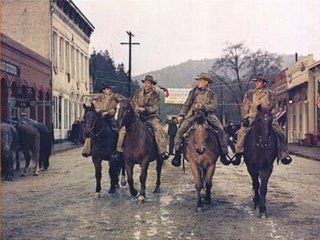Somewhere in the late sixties, the term “Revisionist Western” entered the filmic vernacular. The old, traditional Westerns of John Ford and Howard Hawks were on their last legs, and the new ones that were being made tried to look at things with fresh eyes. Films like “Little Big Man”, “Soldier Blue”, and “Posse” took the Western template and superimposed the values of the sixties unto it. Some of these films were good, and some weren’t, but they all had the conceit that they were taking the Western in new directions.
This idea was, however, completely wrong. It begins with an unspoken assumption that all the Westerns that came before were safe, cookie-cutter product, and that they didn’t really make social statements. Sorry, no. What is John Ford’s “The Man Who Shot Liberty Valance” if it’s not revisionist? What about “Cheyenne Autumn”, or “Two Rode Together”? Hawk’s great “Red River” injected Oedipal shadings into a cowboy setting. Hell, you can make the case for Ford’s “Stagecoach” as a revisionist Western, with its comments on class and social hypocrisy, and it was made in the thirties!

I said above that some of the “new” Westerns were good, and I’d like to comment on one of the best - Philip Kaufmans’ “The Great Northfield Minnesota Raid”, from 1972. This film is built on the Jesse James saga, but it isn’t interested in good guys and bad guys. In this story, there’s enough bile for everyone.
The film opens in the mid 1870s when a bill was in the Missouri legislature that would have offered an amnesty to the James-Younger gang. The gang has staged several high profile robberies, but they have a lot of public support, and a Robin Hood-esque appeal. Cole Younger (Cliff Robertson) is content to lay low and wait for the amnesty to come into effect. Robertson plays Younger as a world-wise sage to whom crime is only a job. On the other hand, Jesse James (Robert Duvall) sees it as a holy calling, a crusade. The Civil War is still going on for him.
Early on, Pinkerton agents ambush Younger and some of the others, and Younger is wounded. James takes this opportunity to plan a daring raid on a bank in the far-off town of Northfield, Minnesota. James is portrayed as a fraud throughout the film, and never more so than here, where he goes into a trance-like state to conjure up the name of the town they will be going to. It is later revealed that Younger had mentioned Northfield before.
The main dynamic in the film is the relationship between the two heads of the gang, Younger and James. Younger is the man of the future, who can see ahead to the time when he won’t have to rob banks. James, on the other hand, is caught in an endless loop of past crimes to be avenged. We hear James recount his time with the Confederacy, and his role with Merrill’s Raiders in the Lawrence, Kansas Massacre.
“They say we killed 1000 Yankees there.”
Younger gets up off his sickbed and goes to try to prevent the Northfield raid, which would jeopardize their amnesty. Hopping a train on the way, Younger learns that the amnesty has been defeated, and thus he decides to go ahead with the raid.
The train ride has gotten him to Northfield ahead of James, and he learns that the bank in question is broke. Younger comes up with the idea of posing as a cattle dealer and fooling the townspeople into putting their savings back into the bank. The bank manager is an accomplice in this, little realizing that he is facilitating the robbing of his own bank.

As it was in “The Wild Bunch”, one of the underlying themes in “TGNMR” is the encroachment of progress and how the old ways are changing fast. There is a little scene where a steam tractor comes around a corner, and the members of the gang are visibly startled by it. A calliope is set up on the street in front of the bank, and the struggle to get it to work mirrors the efforts of Younger to set up his robbery.
The robbery itself is a disaster, as James morphs into a twitching psychopath and kills a bank employee. Two members of the gang are killed, and Younger and the rest go on the run. The pursuit and capture of Younger and his gang are fairly perfunctory, but what is notable is the way they are paraded through Northfield in a cage, like animals. The people come out in droves to gawk and cheer.
Jesse and Frank James, meanwhile have escaped and as they escape on a wagon we get a chilling indicator of the fate of an elderly woman who sheltered them earlier in the film. Jesse doesn’t have time for remorse, however, because he is already planning who will be in his new gang. In his mind, the war rages on.
No comments:
Post a Comment